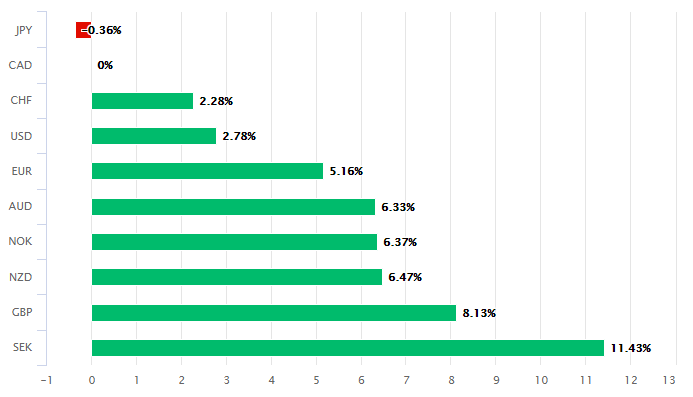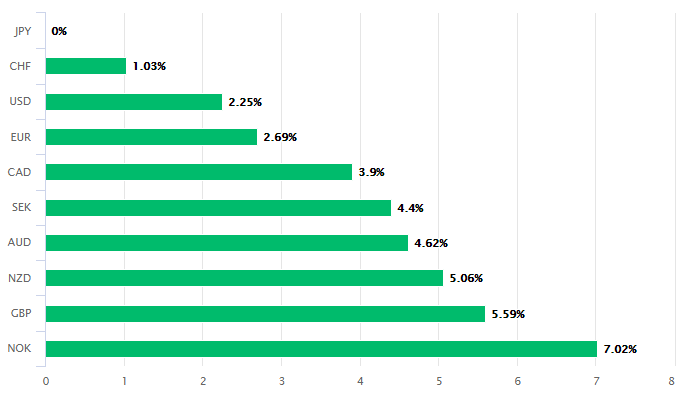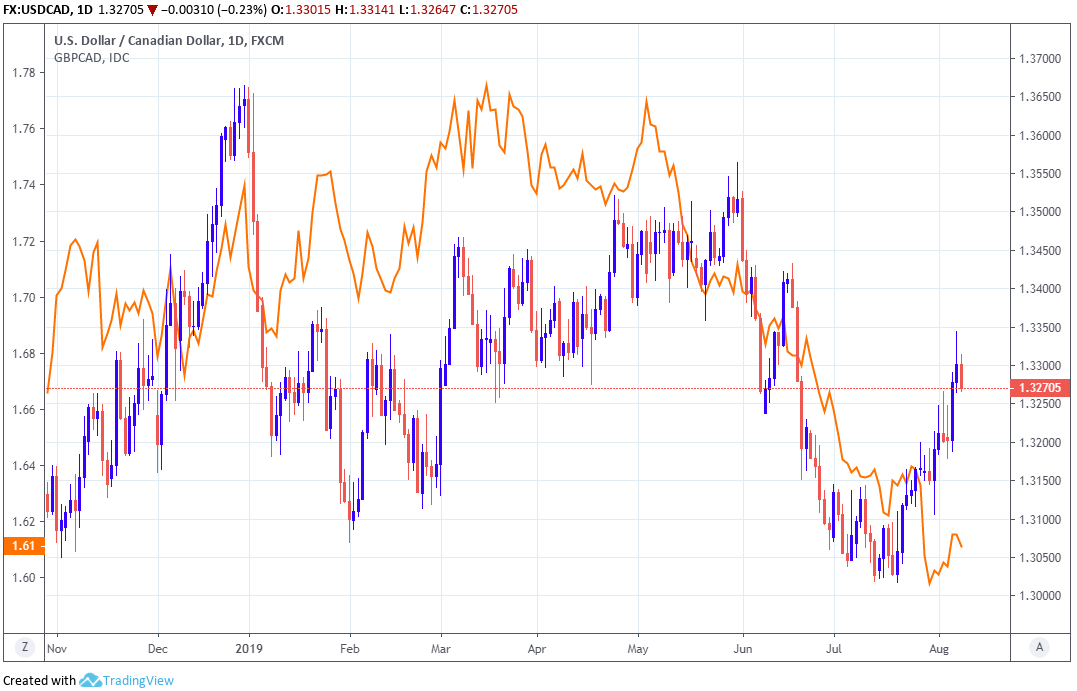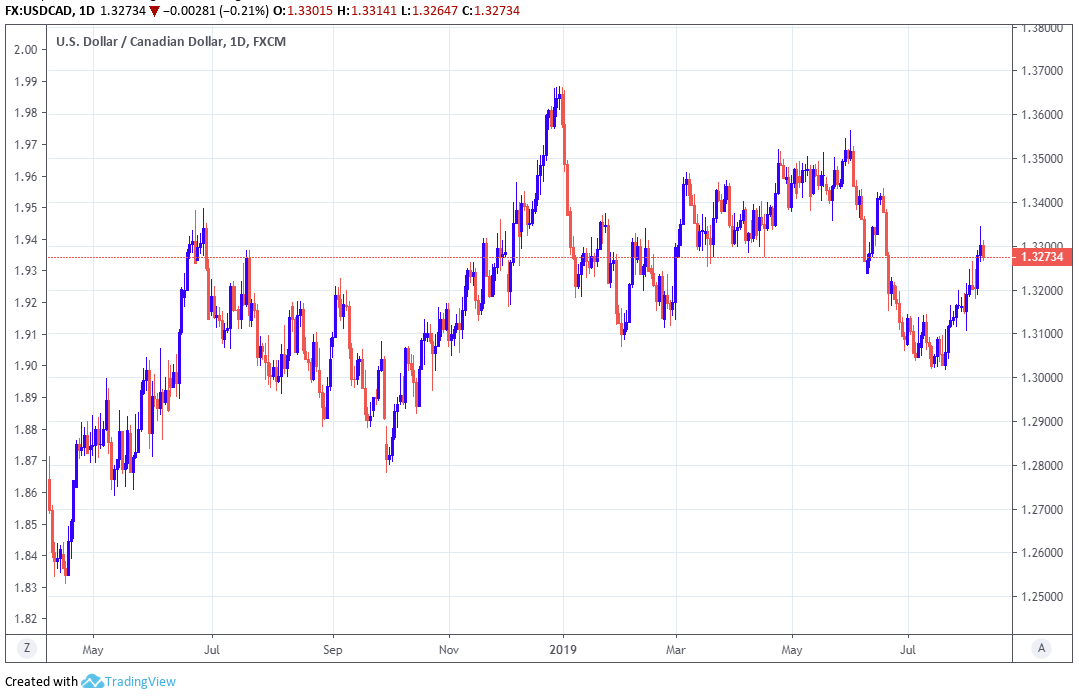The Canadian Dollar has Ceded its G10 Crown to the Yen and is Now Tipped as a Sell
- Written by: James Skinner

Image © Bank of Canada
- CAD cracks, cedes G10 crown to JPY, amid U.S.-China conflict.
- UBS and CIBC both tell clients this week to buy USD/CAD rate.
- CAD set to suffer, further unwind 2019 gains, as outlook sours.
- Trade tensions mean BoC cash rate and CAD will come down.
The Canadian Dollar rose Friday, recovering ground lost to its U.S. and British rivals earlier in the week, but analysts at UBS and CIBC Capital Markets are eyeing a lurch downward from here and have tipped the Loonie as a sell.
Canada's Dollar ceded its previously-iron grip on the top spot in the G10 league table to the Yen this week after falling almost 2% against the Japanese currency amid market concerns the U.S.-China trade tariff fight could soon turn into a 'currency war'. Fears of upset to the global economy and markets have sent investors fleeing from the commodity-centric parts of the world and into the arms of major currencies, particularly so-called safe havens like the Japanese Yen, Swiss Franc and U.S. Dollar.
But with the White House at the centre of global turmoil even the safe-haven U.S. Dollar has begun to trade differently. So far it's bested currencies that are perceived as risky because of their exposure to commodities or China, including the Canadian Dollar, but the greenback has ceded ground to other major rivals. CIBC says this is different to the Dollar's response in the last bout of trade tensions and that it could be indicative of markets now viewing the U.S.-China conflict as more of a 'currency war'.

Above: Canadian Dollar performance Vs G10 rivals in 2019. Source: Pound Sterling Live.
"Prior episodes of ‘currency wars’ have largely been caused by a major central banks implementing controversial easing measures," says Bipan Rai, head of FX strategy at CIBC. "The key this time is that there is concern with respect to China’s FX policy. The worry now is whether China will actively defend the 7.00 handle in USD/CNY, and if not will other countries devalue as well."
The People's Bank of China (PBOC) encouraged the Renminbi to further depreciate this week when it fixed the midpoint of Wednesday's trading band for the USD/CNY rate at 6.9996, close to the psychologically important 7.0 level the market has traded above since Monday. The exchange rate has risen all week after the PBOC set a Monday 'fixing' that was much higher than many local analysts had anticipated, which means it 'fixed" the Renminbi much lower.
Those lower fixings for the state-managed currency, which will offset some of President Donald Trump's tariffs by reducing the cost of Chinese goods for those paying in foreign currency, followed a decision by White House to target China's remaining $300 bn of annual exports to the U.S. with a 10% tariff from September 01. Some analysts say this will rise to 25% sooner or later and markets are now adjusting to the idea that hostilities between the world's two largest economies go on for a while.

Above: Japanese Yen performance Vs G10 rivals in 2019. JPY has risen 1.79% Vs CAD this week.
"The Canadian dollar has been somewhat insulated from the global risk sell-off, but it won't be for long, in our view. The sizeable divergence between Fed and BoC expectations is unlikely to sustain, while exposure to the global cycle via oil should also make CAD vulnerable. Although this is largely a risk-off 'catch up' view, long USD/CAD would likely perform well even under a more positive growth scenario," says Vassili Serebriakov, a strategist at UBS.
Even the Euro, which is at risk from an imminent round of European Central Bank (ECB) rate cuts and other stimulus measures, has risen against the U.S. Dollar this week while a Brexit-battered Pound had fallen just 0.06% by the noon hours on Friday. But Canada's Loonie, which is backed by the second highest cash rate in the G10 world and an economy that's outperformed most comparable rivals in recent months, ceded ground to its U.S. counterpart.
This week's trading pattern for the greenback underlines the extent to which a souring international environment characterised by rising trade tensions, mounting fears for the global economy and falling business confidence as well as investment, is bad for the Canadian currency. UBS says this dour environment will soon leave its mark on the interest rate outlook of the Bank of Canada (BoC), which was one of the things that helped the Canadian Dollar best all its G10 rivals so resoundingly in recent months.
Changes in rates are normally made in relation to the outlook for inflation, which is sensitive to economic growth, but impact currencies because of the influence they have over capital flows and decisions of short-term speculators. Capital flows tend to move in the direction of the most advantageous or improving returns, with a threat of lower rates normally seeing investors driven out of and deterred away from a currency. Rising rates have the opposite effect.

Above: USD/CAD rate shown at daily intervals alongside GBP/CAD rate (orange line, left axis).
"We don't think the divergence of BoC and Fed pricing is justified by solid 'hard' Canadian data," Serebriakov writes, in a research note. "Both central banks appear currently driven by similar considerations more than the market acknowledges. The FOMC cited global risks in its decision to cut rates last month. Meanwhile, the BoC mentioned trade seven times in its July statement."
The BoC said in July it will pay particular attention to "developments in the energy sector and the impact of trade conflicts on the prospects for Canadian growth and inflation" when making future interest rate decisions, after leaving its cash rate unchanged at 1.75%. That rate is much higher than its nearest rival, the Norwegian cash rate of 1.25%, and not far below the new Federal Reserve (Fed) rate of 2.25%.
Those interest rate differentials had proven a significant draw for the Canadian Dollar among yield-hungry investors and until recently, most analysts had anticipated the BoC would be able to leave its benchmark unchanged throughout 2019 due to Canada's strong economy, even as the Fed and other central banks reduce borrowing costs.
Meanwhile, markets have alternated between betting on one more Fed cut this year, and favouring two more, but the consensus looking for continued divergence between U.S. and Canadian policy rates is now beginning to crack. UBS says the market should soon begin betting on convergence, which means a lower Canadian Dollar regardless of whether investors look for such a narrowing rate differential to come by either Fed stability or BoC rate cuts.

Above: USD/CAD rate shown at daily intervals. Price on right axis.
"In light of the surprise darkening in US-China trade tensions in the past week, we're bringing forward the timing of both the next Fed rate cut, and the Bank of Canada's subsequent move," Rai wrote to clients on Tuesday. "We expect the Bank of Canada to cut rates a quarter point in Q1 2020 (rather than Q2), and that cut might be less tied to a C$ appreciation (our earlier view of what would motivate it) than to the need to buttress domestic demand in a somewhat more concerning global environment."
This was after Rai told clients Monday they should buy the USD/CAD rate around 1.32 and target a move back up above the 1.35 handle in the months ahead, which would all but erase the gains made by the Loonie since the end of May. UBS, the global investment bank with roots and headquarters in Switzerland, has also issued a similar recommendation this week.
Serebriakov told clients to buy the USD/CAD rate around 1.32 and target a move up to 1.36 in the months ahead, although he also suggested giving up on the idea if the market falls back to 1.30 or below. The trade is based significantly upon the idea that Canada's economy will cool, fears for the outlook rise and that the BoC will become more uneasy about the current level of its cash rate. However, it's also based in part on the expectation the greenback will be in demand amid the trade war with China.
Time to move your money? Get 3-5% more currency than your bank would offer by using the services of foreign exchange specialists at RationalFX. A specialist broker can deliver you an exchange rate closer to the real market rate, thereby saving you substantial quantities of currency. Find out more here.
* Advertisement




